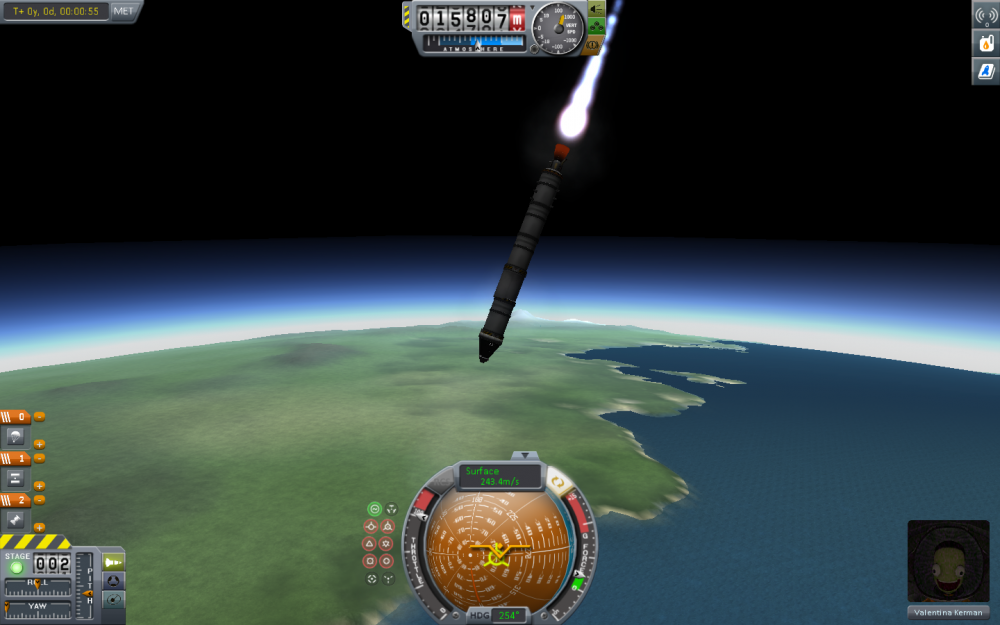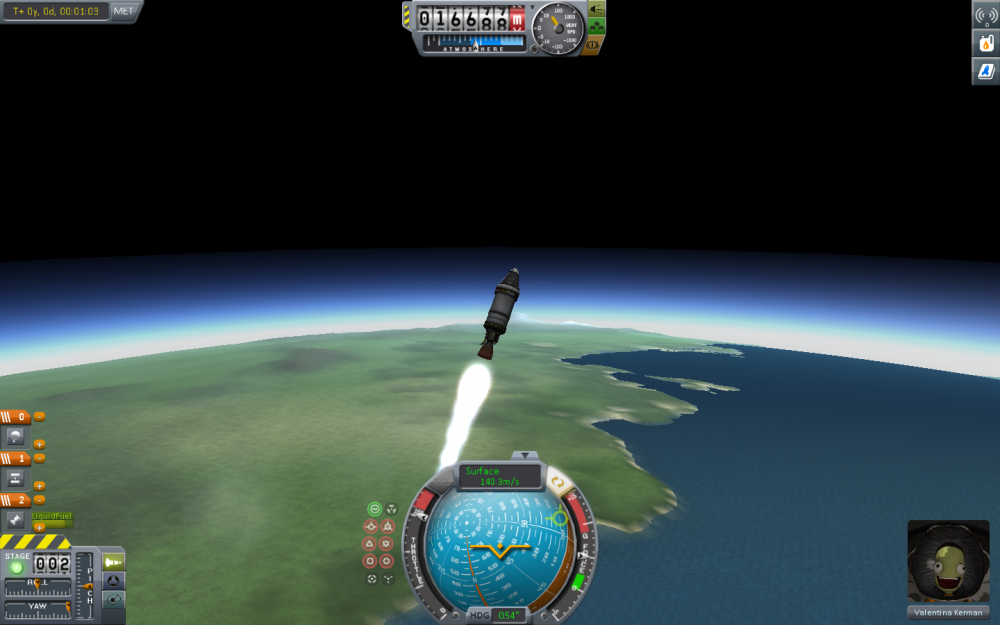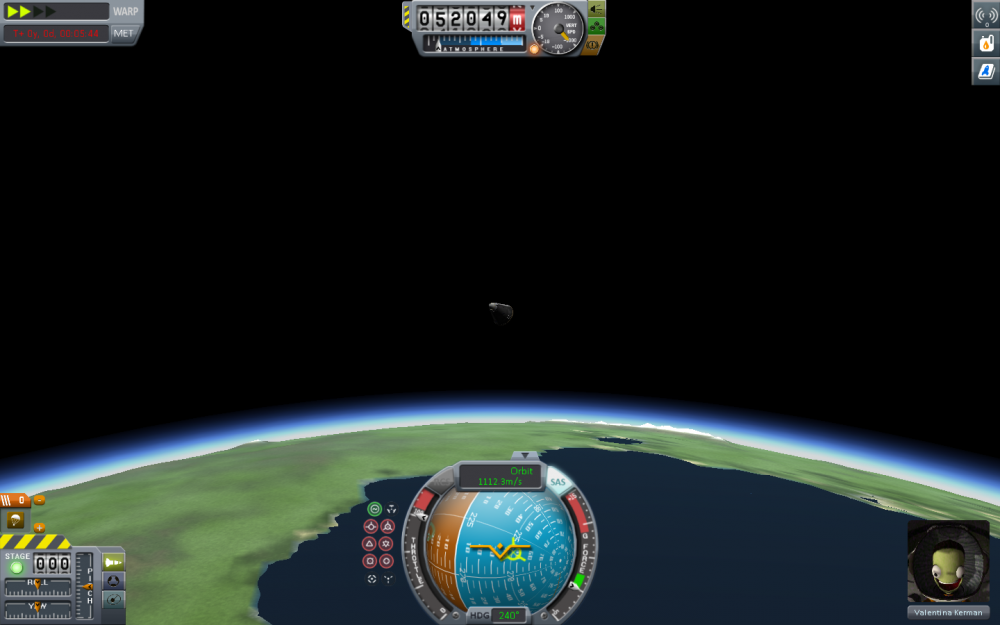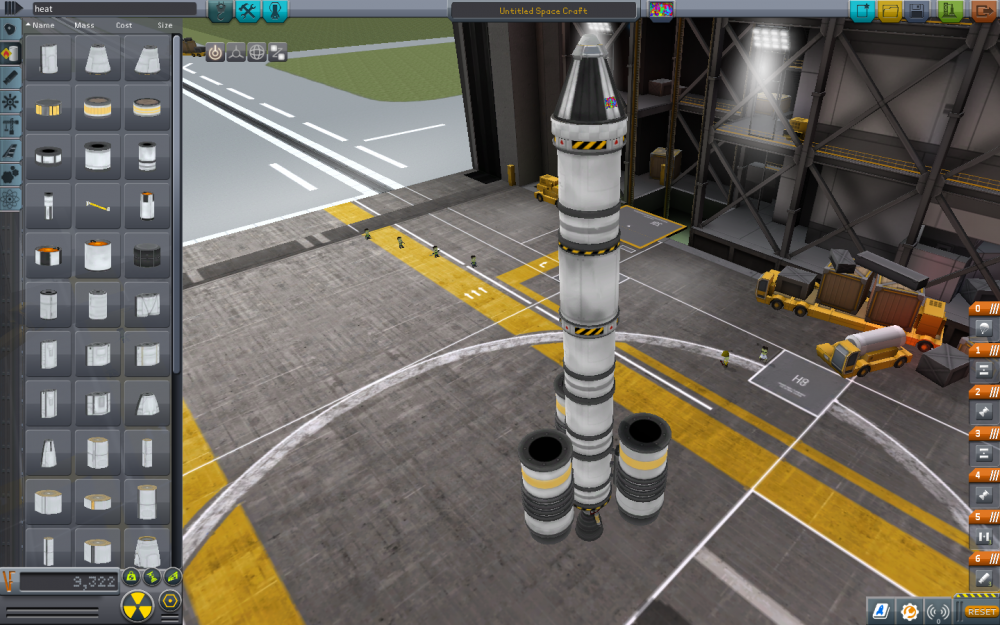
ZZ
Members-
Posts
34 -
Joined
-
Last visited
-
Days Won
1
ZZ last won the day on January 19 2021
ZZ had the most liked content!
Recent Profile Visitors
The recent visitors block is disabled and is not being shown to other users.
ZZ's Achievements
Newbie (1/14)
1
Reputation
-
Time of Launch: 10:52 AM Team members present: Ethan Smith, Zach Zlotnick Play by play: The rocket was launched with the boosters and accelerated to around 300 m/s. A gravity turn was executed to give the craft a parabolic path and it was ensured that the heading of the rocket lined up with the velocity vector so that torques exerted by air resistance was minimized. This gravity, which turned into something that was anything but “slight,” eventually caused a major disproportion in the balancing of CW and CCW torques. Our rocket, as can be observed in the screenshots, ended up plummeting to the surface of the earth at obscene speeds that terrified Valentina Kerbal before her most unfortunate of fortunes. We regretfully will pay any imposed fines, although we never really liked Valentina. Time of flight: 6 minutes 55 sec Summary: We were shockingly far away from our initial goals of this destructive mission. While we did not accomplish our goal, we did manage to almost bring the Kerbal back from 50,000m (but she exploded upon impact). Opportunities, learnings: We learned that although we used to be very close, this new design by ZZ was possibly one of the worst in Kerbal history, and Ethan will return as project manager in our next expedition of the unknown. Strategies/ Timeline: Tomorrow we going into orbit, boi. The loss of life was once again unfortunate, and few strides were made in science today at all. We just need to modify the flight plan of the previous rocket to allow successful orbit. Milestones: killed Valentina Available funds: 31,737
-
Team Name: ZZ Smith Research Available Funds: 51,059 Vehicle Name: S.A.D. Vehicle parts: Part Quantity Price TT-38K Radial Decoupler 3 600 MK1 Command Pod 1 600 FLT 400 Fuel tank 4 500 Stack Decoupler TR 18 A 2 400 LVT 30 Reliant liquid fuel engine 2 1100 MK16 Parachute 1 422 RT-10 Hammer Solid Fuel 3 400 Design Goals: We took the design from our previous rocket that was sadly not able to quite make it into stable orbit as we initially hoped it would. In this one we added three boosters to give it an extra “kick” which will bring our kerbal to and from orbit. We have contracted ZZ's intelligence to craft this work of art. Launch Goals: We are hoping to make a feat for all kerbal-kind and to reach and return from the deadly orbit mission. We have failed many times previously, but this isn’t going to stop us from killing more kerbals if need be. Pilot Plan: The pilot will fly the craft and once it reaches 100 m/s he will begin to turn the craft to 10 degrees. This will cause gravity to bend the path of the rocket as it accelerates. Once the first stage runs out, the pilot will jettison the initial booster and fuel tanks and activate the second stage. The secondary booster will provide acceleration into space and from there the craft will burn into orbit. Hopefully enough fuel will be left to get home, in which case the pilot will have to keep the heat shield going against the atmosphere and use the parachute to not crash into the ground at high speed.
-
The other day I was watching a soccer game, West Ham United vs Arsenal FC. I know I do blogs on soccer all the time but it's because I am just so fascinated by the things these players are able to do, hence why they are professionals. One of the players, Andy Carroll scored a bicycle kick, where a player flips himself/herself upside down with their foot in the air and kicking it over their head (sometimes referred to as an "overhead kick"). While this one was good, it reminded me of one from several years ago that another professional, Wayne Rooney performed in a game. Here's the video: While this goal may still have you in awe (this happens maybe once every several years by the way), I'd like to start talking about the physics. So it all started with the crosser, Nani, who crossed the ball in at about 22 mph (the speed of an average cross). This speed of the ball means the reaction window for Rooney was microscopic, even to just put the ball on target - much less the upper corner of the net. A half second too quick or too slow and this bicycle kick will end up on the blooper section of sportcenter. Upon timing the jump, Rooney is in the air for about 3/4 of a second, meaning the margin for error is quite small. Rooney's foot has also been measured to be 1.80 meters above the ground (5'9") which is about the same height as Rooney. So you might ask, what is the advantage of doing this if he could've headed the ball instead? While this is normally what players do in this scenario, a header simply wouldn't have provided the same force (and thus acceleration) on the ball. This is because of the net torque on the ball. With a header, one really only uses a little less than half of their body to cock back and snap into the header to deliver a net force upon it. However, with a bicycle kick the whole body is involved. Since the body in midair experiences no outside forces, it acts as if it were a rotating object, where both halves of the body contribute to a clockwise motion to allow a well powered kick. In addition, you will notice that he kicks one leg first and then the other. This has to do with momentum. as he generates momentum in one direction, this allows him to change the motion with the other leg and allow a greater velocity with his kicking leg before it makes contact with the ball. All in all this stands as one of the best premier league goals of all time, ask anybody. It's really cool now to understand how Rooney did this (I know I never could)
-
In my previous blog I discussed the physics behind Kobe jumping a pit of snakes, which I believe is legitimate (or at least physically possible). Now I'd like to discuss another instance of Kobe's famous athleticism: him jumping over a car moving towards him. This one seems fake to me in theory because the consequences of the stunt are too much to warrant him doing it. However, I still think it'd be cool to think about the physics of it. This one is definitely faked. If you were to scale Kobe like in the previous video and analyze the motion. His acceleration was -6.76m/s^2. This is 3 units away from the actual acceleration due to gravity. So something is telling me that there were strings of some sort attached to him allowing him to jump with a longer hang time and avoid the car. Could Kobe do it if he were feeling bold enough? I believe in his prime, with his vertical jump, he could do it. The only problem is that the car would need to be going fast. This would mean that his reaction times would need to be as close as 1/100 of a second or he would get hit or touched in mid-air. This is why I believe it is fake; it is physically possible, but in terms of probability and natural human error (please don't give me a 0 for this blog now!) I believe he wouldn't have done this.
-
Kobe Bryant just retired after 20 years at the Lakers. As a player straight from high school into the NBA he has set many records and is arguably one of the best basketball players of all time. One thing that him and other basketball players are known for is his jumping (which might not be as good as it was 10 years ago). I figured this would be as good a time as ever to analyze his jumping skills in two videos - one of him jumping a pit of snakes and dunking a ball, and of him jumping over a car (in my next blog post). Many believe that neither were real, so I'd like to discuss the physics of both stunts. So the video above is of Kobe jumping a pit of snakes (I'd assume not venomous since other people were in the pit before him). After some statistics were found on this, it was calculated that his vertical acceleration was -9.56m/s^2, which is close enough to an object's acceleration due to gravity (9.81m/s^2). This evidence points to it being real, since air resistance should account for a decreased acceleration in either direction. After scaling Kobe to the pool it can be concluded that the pool is about 12 feet across. Using various displacement measurements, The horizontal velocity of Kobe can be determined to be a little less that 12 mph - a realistic velocity as well. Given the two data sets I can only assume that this jump could be realistic, since Kobe Bryant has a crazy amount of athleticism. I think that it could be real, but this one comes down to decision making - and I'm not sure Kobe would risk anything on a stupid (yet interesting) stunt.
-
So the other day at lunch when a couple of us were spitballing ideas for blogs, I figured what's better topic than spitballing itself. To test the physics of this I took a straw from the lunchroom and a smaller one from a different chocolate milk container of mine, with a similar radius. I blew projectiles (not at anyone) and found that the larger straw sent them further and faster than the shorter one. This is most likely because the longer the force I exerted on the spitball was, the larger the impulse (change in momentum) it would feel. The longer a force is applied on an object, the faster it will go and therefore the farther it will travel. It's amazing how in even the most primal of children behaviors physics can be involved.
-
Yesterday I was watching soccer on TV and saw Ronaldo notch a hat trick...yet again. However, I rather began to ponder the physics behind being a goalkeeper to stop shots - maybe not as perfect as Cristiano Ronaldo's. Physics can separate the good from the great goalkeepers. Here are some factors in being a good goalkeeper: 1. Momentum- A goalkeeper must have his/her weight shifted forward, standing on their toes. When a shot comes, the goalkeeper will try to save the ball while moving forward. Therefore, due to conservation of momentum, they will deflect rebounds away from the goal as opposed to in the goal. 2. Vectors- While preparing for a shot, a goalkeeper must analyze vectors to determine a good place to stand - in the most probable path of the ball. If the forward is on the goal line (outside the goal) the goalkeeper should probably stand a step or two off his line, toward the back of the goal, to prepare for a cross (unless they have a crazy ability to curve the ball as seen in my previous blog on curve in soccer). 3. Impulse- The best goalkeepers always buy the most expensive goalie gloves. This is because not only they can afford this luxury, but the better gloves will increase the time the force of the ball is applied for, thus increasing the impulse. Not only will cheaper gloves be much less effective in helping the ball stick, but they will reduce the amount of impact time and increase the chance of a rebound (which is a major source of goals in the game of soccer). I am not the best goalie clearly, seeing as I don't even play goalie, but I believe most keepers with a basis of physics knowledge would agree with me on this!
-
Recently I've had a little bit of a pickle fetish. However, one of the things that is inevitable for us regular pickle-eaters is the difficulty in taking of the lid of the jar. One tip I have is to run the jar under hot water. This way the lid will become easier to turn. This is because metal has a higher coefficient of expansion than glass does. Thus, as the jar stays under the hot water, the metal expands a tiny bit, and the glass stays the same (I also find it easier to use my left hand because it's easier to turn CCW with your left than your right). The other tip I have would be to hit the gym and organize a forearm based workout session because without the hot water trick I've got just about nothing. Good luck in your future pickle jar opening endeavors.
-
Like many other students, I am looking forward to summer. One activity many people enjoy is water skiing! Water skiing has a lot of physics involved. The basics are essentially based on angles and gravity. When you get up from the start, your ski must be at a certain angle so that the water pushes down on the ski, creating a downward force that enables you to stand up (otherwise you'll just fall flat on your face). Once the forces up from the water and down on the ski are equal, you're set for takeoff! Tension, a pulling force, is also involved when the skier holds on to be pulled by the boat. Once the tension in the rope becomes constant, you will travel at the same speed as the boat that is pulling you, since there is a constant force with no acceleration. Also, since you are usually moving in a circular path, there is also an inward, or centripetal force, keeping the you in a circular path. Can't wait to go do it this summer!
-
The other day I went to do my weekly chores, one of which was picking up and setting new mouse traps if needed. It turns out that today was an unlucky day for a certain rodent. I grabbed myself a new mousetrap after cleaning up the carnage from before, and began to set it. Now that I've set many before it does not seem too hard anymore, but it still requires a lot of care when handling one, since it could seriously injure an appendage if set off accidentally. I thought about it and realized that a mousetrap is really just a balancing act with equal torques on each side (F*r = F*r). The way a mousetrap is made it uses a two-lever system, in such a way that a small force exerted on the bait will trigger the trap and thus kill its worthy victim. The arm lengths have much different lengths, in that L1<<L2 and d1<<d2. Therefore, even just a tiny extra force at the bait will be able to trigger the trap. This is why it takes so much less work to fix the trap than to set it off.
-
Once upon a time, in a school far far away, Mr Muz told us that a cat has a natural ability to be able to land from a building without dying. I figured, "if there's no physics explanation to this phenomenon that would be shocking." What confused me the most wasn't the landing, because cats can get injured from the stress put on their legs from extreme distances, but how the cat can maneuver its body in the air so quickly and that it lands on its feet. This is something humans cannot do without defying the laws of angular momentum. Let's say on a trampoline I try a flip; there's no way for me to change the direction of that flip even if I had a 20 foot drop off, unless acted on by an outside force. This makes sense to most people, however you might mention that the cat isn't acted on by an outside force either, so how can it spin? It turns out, the cat has a natural ability to contort its back and legs, much like an ice skater does while spinning, to change the way it spins. To do this they shoot their hind paws out and tuck in their front paws - lowering the moment of inertia in the front and increasing it in the back. This results in a big front twist and a small twist in the back, therefore the torques will be balanced (T = Ia). Once the cat wants to stop the front twist it will push its legs back out to increase its inertia. It will also extend its back legs again to twist them and put them back under their body before impact. From here it is the cat's natural fall-breaking abilities that help it - by having a slight give when hitting the ground it increases the time the force is felt and lowers the change in momentum. All in all I think I learned something very valuable, that is if a cat is stuck in a tree it really shouldn't be a big deal. Rather, we should worry more about ourselves getting stuck because we don't have a prayer of surviving a fall from more than a single story.
-
Recently while fishing for some blog-worthy material I stumbled upon one of my favorite youtube channels that posts cool videos on all sorts of sciency stuff. Since magnetism is not the most heated of debates amongst us students for some odd reason, I figured a video on magnetism might spice things up a bit for me. I learned about a whole new type of manufactured magnet that I thought would look really interesting to a technology guy like me. Now we all know about magnets, right? One end is south and the other is north. You can use put your failing grades from physics and calc tests (at least I can) up on the fridge for mom and dad to see. They're fun to play with. However they do have some other more important uses such as the ones in your refrigerator, car brakes, or screen displays. New magnets, however, are not only beginning to be made with multiple poles on one side, but programmable polarities - meaning a pattern of polarities can be programmed on software and the magnetic field can be "printed" onto a magnet. This means that you could print as many poles in whatever shape you desire. One of the benefits of this is that a very distinct shape could be printed between two magnets and allow them to attract each other only up to a certain point. After that point they will repel and only continue to attract once aligned properly. Although it just seems cool at this point, it could be useful in door and hinge technologies, allowing easier opening and closing. Magnetism isn't heard about often for a reason, because there's a lot we (especially me) don't know yet. However, I thought the fact that we can create magnets with multiple poles on each side, or "polymagnets," was a pretty cool thing.
-
Pizza tossing is something that looks absurd at first - throwing dough into the air and spinning it around like a basketball on your finger. As it clearly takes a lot of skill, it also possesses several aspects about physics. Most obviously the pizza is given a centripetal acceleration of v^2/r and a force of mv^2/r and it can be treated as an object in uniform circular motion. The most ideal motion for a single toss is a spiral trajectory. When this dough is at rest the tosser must apply a torque to give it an angular acceleration (Aang = Torque/Inertia). The ideal motion of multiple tosses is a semi-elliptical trajectory. In this case the tosser will not have the dough completely flat and it will fly through the air at an angle. This requires a ton of skill and experience on the tossers part. Another aspect about pizza tossing is impulse. When the tosser is catching the pizza after finishing the process, he/she obviously doesn't want to rip the pizza and start over. In order to prevent this, they must lower their hand slightly slower than the speed at which the pizza is falling in order to increase the landing time. Since impulse is equal to the Force x Contact Time, this would deliver a smaller change in momentum for the dough and lower the chance of the dough ripping. Lastly, the force of friction plays a big role. The addition of flour in making the dough allows for a lower coefficient of friction and makes it slightly harder, since there must be enough friction for the tosser to thrust the dough into the air and spin it quickly, or it will end up ripping. When making the perfect pizza you must try to increase the amount of friction. Even though I have no idea how to toss dough in order to make a pizza, I do thoroughly enjoy consuming pizza, as it is a great bridge between all of the food groups
-
Something I used to love using as a kid was a slingshot. It's so fascinating that a mechanism as simple as one of these can shoot something so fast. I thought I'd go through some of the physics behind this. As the elastic band is stretched, the potential energy stored is similar to that of a spring. However, the longer you take to aim the slingshot, the more potential energy you lose due to heat loss (aim fast!). If you happen to be making your own slingshot you would think that using a thicker band would have a higher spring constant and thus a larger exertion of force on whatever object is being flung, right? Against what your initial beliefs might be this is in fact not true, as a tapered band will be faster than a thicker band because it is more efficient when converting the potential energy into kinetic energy for some reason. The other interesting part about a slingshot is that, like we discovered in class with the egg drop, rubber does not obey Hooke's Law that says the Force of a spring system is equal to the product of the spring constant and the displacement. The force required actually increases in a curved, exponential fashion, whereas if you graphed Hooke's law it would be linear. If you wanted to find the force of a non-hookean solid then you could, however there are several other things to consider, such as a shear modulus or a bulk modulus, that just makes it difficult and much more complicated. Using a slingshot is fun, however make sure you use it for good and not evil.
-
One sport other than soccer that I feel I have a skill set in is badminton. It may look somewhat easy to a first-timer but there is a lot of strategy involved as well as skill obviously. Badminton is one of the fastest sports there is, faster than soccer, tennis, and even baseball. Usually it is played indoors, if played as an official sport, since the birdie can be very easily manipulated by the weather conditions. There are four basic shots: A smash, clear, drop, or drive - all of which should be used in distinct scenarios. This shuttle, or birdie, is very unique because it is designed to slow down after being used by using feathers from a goose/duck; this leads to a more predictable flight path and more control on each shot. If you ever find yourself in a match and want to make it more interesting, try tucking the feathers in slightly in order to achieve a much faster shot due to lesss air resistance. It also will always travel nose first since the center of mass lies there. Badminton players (professionals of course) can hit a birdie, 200 mph or even faster. However this is because they hit it at an optimum angle of about 72 degrees, which they usually jump to obtain. This angle and technique helps to transfer as mechanical energy possible to the shuttle when being hit, and ultimately the most velocity. Usually it is played indoors, if played as an official sport, since the birdie can be very easily manipulated by the weather conditions. There are four basic shots: A smash, clear, drop, or drive - all of which should be used in distinct scenarios. Because of all these reasons, badminton may be one of my favorite sports other than soccer.
Terms of Use
The pages of APlusPhysics.com, Physics in Action podcasts, and other online media at this site are made available as a service to physics students, instructors, and others. Their use is encouraged and is free of charge. Teachers who wish to use materials either in a classroom demonstration format or as part of an interactive activity/lesson are granted permission (and encouraged) to do so. Linking to information on this site is allowed and encouraged, but content from APlusPhysics may not be made available elsewhere on the Internet without the author's written permission.
Copyright Notice
APlusPhysics.com, Silly Beagle Productions and Physics In Action materials are copyright protected and the author restricts their use to online usage through a live internet connection. Any downloading of files to other storage devices (hard drives, web servers, school servers, CDs, etc.) with the exception of Physics In Action podcast episodes is prohibited. The use of images, text and animations in other projects (including non-profit endeavors) is also prohibited. Requests for permission to use such material on other projects may be submitted in writing to info@aplusphysics.com. Licensing of the content of APlusPhysics.com for other uses may be considered in the future.






